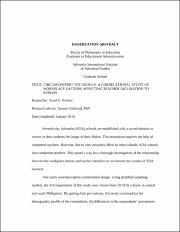| dc.description.abstract | Seventh-day Adventist (SDA) schools are established with a sacred mission to restore in their students the image of their Maker. This restoration requires the help of competent teachers. However, due to very attractive offers in other schools, SDA schools lose competent teachers. This paved a way for a thorough investigation of the relationship between the workplace factors and teacher retention to circumvent the exodus of SDA teachers.
This study used descriptive-correlational design. Using stratified sampling method, the 424 respondents of this study were chosen from 28 SDA schools in central and south Philippines. By getting their perceptions, this study examined (a) the demographic profile of the respondents; (b) differences in the respondents’ perceptions
on the workplace factors in terms of demographic variables; (c) relationship among workplace spirituality, working conditions, and incentives; (d) relationship between the workplace factors and teacher retention; and (e) the best predictive model for teacher retention.
This study found that those teachers who had served the current school the most were more aware of teacher collegiality and career growth incentives. The results also show that workplace spirituality (r = 0.58), administrative support (r = 0.67), and teacher collegiality (r = 0.59) were significantly related to career growth incentives. Moreover, all the workplace factors had significant positive relationship to teachers’ decision to stay in the current school they served.
Using multiple regression, this study developed 3 predictive models—Model 1: stay in current school, Model 2: leave the current school but stay in SDA school system, and Model 3: leave SDA school system. The result also shows a number of factors that helped predict the models. These factors include workplace spirituality (Models 1, 2, and 3), financial incentives (Model 1), serving 1 to 5 years (Model 1), master’s degree (Models 2 and 3), teaching in tertiary levels (Model 3), and rural school (Model 3).
The recommendations made for SDA school administrators included the design of programs to enhance the workplace factors to retain more competent teachers. Further studies can consider determining other factors that can help circumvent the exodus of SDA teachers. Future research can ask, “What do the teachers expect to happen in the school?” rather than “what is happening in the school?” | en_US |

